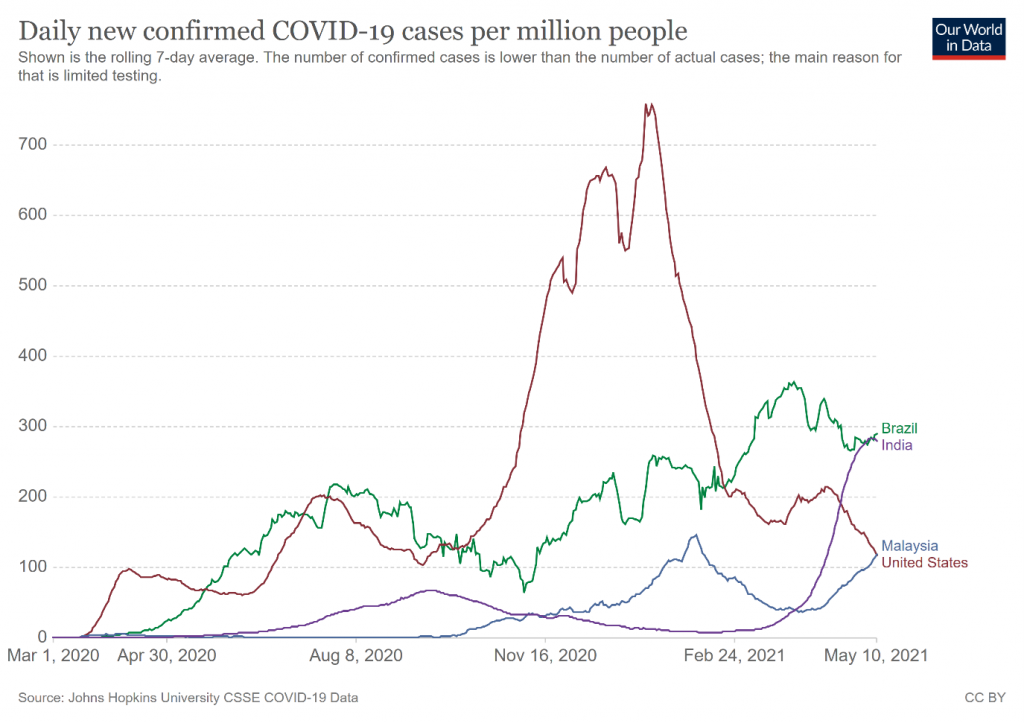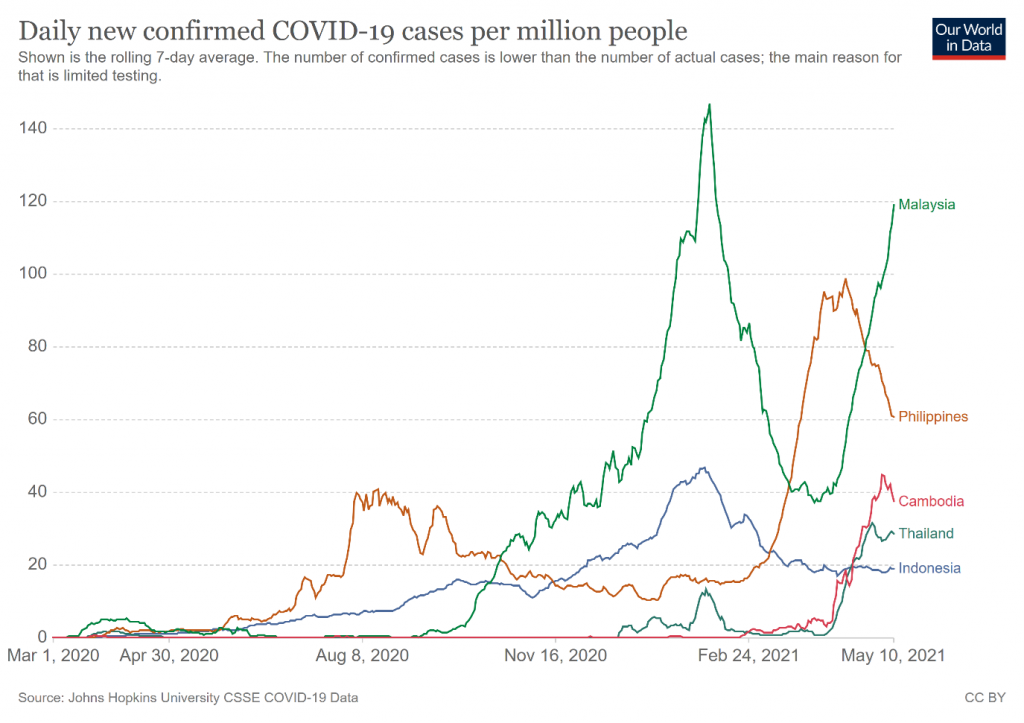Science has been and will continue to be the foundation of the management of Covid-19. This is evident from the experience of Brazil, India, and the United States.
Brazil
The cumulative number of positive Covid-19 cases in Brazil was 7,563,551 on 31 December 2020. This rose to 15,145,879 on 10 May 2021, an increase of 200.25%.
Brazil’s death toll is the second highest in the world with 421,316 deaths as at 10 May 2021.
Although there is agreement that the highly transmissible P.1 variant contributed to the current surge, Brazilian scientists’ view is that governmental inaction allowed spread of the virus.
The variant probably emerged in the Manaus, a city on the Amazon, in November 2020. After Manaus was overrun with P.1 infections in January 2021, scientists pleaded to politicians to shut down travel to and from the Amazon. But infected patients and their family members were airlifted across the country for treatment and transport hubs remained open. By March 2021, P.1 was the dominant variant in six of eight Brazilian states studied. Although some neighbouring countries tried to shut themselves off from Brazil, the P.1 variant has spread beyond.
Jesem Orellana, an epidemiologist at Fiocruz, the renowned scientific research institution, said on 10 March 2021 that because of its epidemic, Brazil was “a threat to humanity”.
President Jair Bolsonaro has consistently mischaracterized COVID-19 as “gripezinha” (little flu”) and has refused to consider scientific advice on numerous occasions e.g. mask wearing and limiting people contact, and promoting unproven purported cures. Despite evidence that face masks can reduce the likelihood of spread, he weakened a federal mandate for mask wearing in July 2020.
Despite testing positive for Covid-19, he continued to refuse mask-wearing himself. State governors who enforced them were labelled “tyrants.” This was despite evidence from a study that tracked the outbreak from February to October 2020 which found that regions which implemented strict measures like mask wearing and lockdowns had fewer deaths per capita than other regions which did not.
Despite more than 60,000 deaths in March 2021, which was double that of February 2021, Bolsonaro railed against the lockdown measures imposed by governors and mayors, stating: “We had, and we have, two enemies – the virus and unemployment! It is a reality! We are not going to solve this problem by staying at home.”
Brazil has had four health ministers since the pandemic began. In a Senate testimony, Luiz Henrique Mandetta, who was the first health minister to be sacked, stated that Bolsonaro ignored repeated warnings that his non-Science approach to COVID-19 could cause the health system to collapse. He added that Bolsonaro led the Brazilian people into a canyon and that government won’t be able to coordinate an effective health response until there is political leadership.
Brazilian scientists also state that the situation has been worsened by Bolsonaro government’s promotion of misinformation. Prof Mauricio Nogueira of São Jose do Rio Preto School of Medicine has questioned whether focusing solely on the new variant downplayed government mis-steps and widespread misinformation about COVID-19 treatments that have contributed to the current crisis.
Many experts are of the view that the Brazilian government’s response has been lacklustre, at best, and downright dangerous, at worst.
India
The cumulative number of positive Covid-19 cases in India was 10,266,274 on 31 December 2020. The daily cases peaked at about 96,000 in September 2020 and declined slowly to about 12,000 by early March 2021.
Prime Minister Modi, in an address to the World Economic Forum’s Davos Dialogue on 28 January 2021, stated: “Last year, in February-March, a lot of experts had said the India will be the worst-affected country, there will be tsunami of cases. They predicted 2 million deaths in the country. But India moved ahead with a proactive public participation…Today, India is among countries that have succeeded in saving the maximum lives. The country, which comprises of 18% of the world’s population, has saved the world from disaster by bringing the situation under control.”
Since the beginning of 2021, businesses reopened. The government permitted and, in some instances, encouraged large gatherings, including protests; election rallies and religious gatherings which continued during March and April. Complacency crept in. This was reflected in the country’s Covid-19 task force not meeting for months.
The world’s attention has been focused on India since April 2021. The cumulative number of positive cases on 1 March 2021 was 11,112,241, an increase of 108.24% from 31 December 2020. Since then, it has risen to 22,662,575 – an increase of 220.74% from 31 December 2020. There were 3,500 to 4,000 deaths daily, with a total of 246,116 reported as at 10 May 2021, the third highest in the world. There has been widespread media coverage, with grotesque images of shortages of intensive care unit beds, oxygen, and medical equipment; stacks of deceased bodies and overfilled crematoriums.
Access to data has been problematic in India. This has hampered the provision of evidence-based advice to the government. Despite this handicap, Indian researchers had warned the government in September 2020 about the relaxation of Covid-19 restrictions (Lancet 396, 867; 2020). On early March 2021, the Indian SARS-CoV-2 Genetics Consortium (“INSACOG”), a forum of scientific advisers established by the Indian government in December 2020, warned the health ministry about the new variant, B.1.167, with increased transmissibility and immune escape features.
Shahid Jameel, chair of INSACOG’s scientific advisory group, said he was concerned that the authorities did not pay enough attention to the evidence as they set policy. “Policy has to be based on evidence and not the other way around…I am worried that science was not taken into account to drive policy…As scientists we provide the evidence, policymaking is the job of the government.”
Rupa Subramanya, a researcher and commentator, wrote: “An important country has been brought to an abject state by multiple failures of its leadership. Indeed, the magnitude of the current debacle is matched only by the boastfulness of Modi’s previous rhetoric: that under his visionary leadership, the 21st century would belong to India. With Covid-19, reality has finally caught up with the rhetoric.
“Modi’s shining India has now been shown up to be little more than a facade, built upon image management and marketing, which has now collapsed like a house of cards. Not only has India’s image in the world taken a beating, but its credibility as a reliable partner under Modi’s wayward leadership is also seriously in doubt.”
United States
The United States (“US”) has the highest number of positive Covid-19 cases in the world. The cumulative number of positive cases was 19,346,790 on 31 December 2020. This rose to 33,424,637 on 10 May 2021, an increase of 172.76%. The death toll in the US is the highest in the world with more than 570,000 deaths as at 10 May 2021 and it was the third most common cause of death in the US in 2020.
Deborah Birx, the coronavirus response co-ordinator in the Trump administration, stated in an interview: “The first time we have an excuse. There were about a hundred thousand deaths that came from that original surge. All of the rest of them, in my mind, could have been mitigated or decreased substantially.”
Former President Trump and some others predicted early on that Covid-19 would prove no more than a bad flu. That claim was used to argue that stay-at-home orders and government-imposed lockdowns were un-American and a gross overreaction that would cost more lives than they saved.
Advice from scientists in the Trump administration and the Centre for Disease Control (“CDC”) were ignored. Although Trump himself was infected by the virus, he continued to go about without a face mask and physical distancing, and encouraged the population to do the same. Despite getting vaccinated subsequently, he did not encourage Americans to get vaccinated.
It was only when President Biden took office that the disease was addressed with Science. Mask wearing and physical distancing were made mandatory in federal buildings and functions. Biden, his officers and numerous public figures set an example for the population. The principle taken by the Biden administration was to control the pandemic with Science.
The CDC’s functions were restored and scientific advice was not ignored. Vaccination was rolled out on a massive scale. The target of 100,000 shots by 30 April 2021 was exceeded by more than two times, with more than a third of Americans fully vaccinated and more than 50% having have one vaccine dose at the beginning of May 2021. Since then, newly confirmed cases, hospitalisations and deaths have fallen markedly.
Malaysia
The question as to whether Malaysia will emulate India’s experience has been raised not only in academic discussions but also in the public domain.
The cumulative number of positive Covid-19 cases in Malaysia was 444,484 on 10 May 2021 compared to 113,010 on 31 December 2020 – an increase of 393.31%. On 6 May 2021, Malaysia’s ranking in the global league of cumulative confirmed cases was 42, a jump from a ranking of 85 on 18 November 2020.
Vaccination progress has been slow with about 720,000 having been fully vaccinated as at 10 May 2021.
Whilst the number of daily new confirmed cases have been on a sharp downtrend in the US since January 2021, it is still trending upwards in India and Malaysia, and appears to be trending sideways in Brazil. (Figure 1).

Within ASEAN, the daily new confirmed cases have been trending upwards in Malaysia. The trend was upwards in the Philippines, Thailand, Indonesia and Cambodia initially. This was followed by an obvious downward trend in the Philippines and Indonesia, and an apparent one in Cambodia. The trend in Indonesia and Thailand currently appears sideways. (Figure 2)

The daily new confirmed deaths have been on a downward trend in the US, since January 2021, and in Brazil, since early April 2021. On the other hand, it has been on an uptrend in India and Malaysia. (Figure 3) There were 471 Covid-19 deaths in Malaysia as at 31 December 2020, and 1,700 as at 10 May 2021 – an increase of 360.93%.

The Malaysian government’s response to the surge in late 2020 was the promulgation of an Emergency with the suspension of Parliament, on 12 January 2021, and the introduction of the Movement Control Order (“MCO”) 2.0, on 13 January 2021. The Health Director General claimed that MCO 2.0 slowed the increase in the numbers of positive cases.
The MCO was replaced with the Conditional MCO (“CMCO”) on 5 March 2021. The decline in the numbers of positive cases only lasted 4 weeks. This was followed by marked increases in the daily numbers of positive cases. (Figure 4) It was apparent that the MCO 2.0 was lifted prematurely.

Lessons
Although Brazil and India are in two different continents and thousands of miles from each other, the near apocalyptic situations in both have been consequential to political failures. Their governments have either failed or been slow to act on Science. This has contributed to a virtual collapse of their health systems and the unnecessary loss of lives.
The leaders of Brazil and India did not act decisively when needed. The basis of their responses was not Science but politics. Evidence was ignored or there were delayed responses or both. Misinformation was rife in public messaging. Both the Brazilian and Indian governments missed out on the crucial opportunity to reduce the morbidity and mortality of Covid-19.
This was the same in the US but since President Biden took office, Science has been the basis of the government’s response. The US data since then has increasingly been brighter.
The reader can decide whether there are similarities or differences in the Malaysian response compared to that of the three countries mentioned above.
Decisions need to be swift and evidence-based in managing Covid-19. It is difficult to make prudent and effective decisions with information that have not been well analysed, more so when the information is incomplete.
Health data needs to be accurate and accessible to clinicians and researchers in the management of patients and the public health. The denial or obfuscation of access can only lead to a prolongation of the public’s sufferings.
It is apparent that the Malaysian government is not availing itself of the expertise available in the private sector and universities, many of whom have the capacity and capability to provide analytical services, management options etc.
The Malaysian government’s response to the surge after the CMCO was lifted was MCO 3.0. Are there measurable objectives of this decision?
The government has a critical decision to make. If it continues with measures that have not succeeded in controlling the pandemic, there is a distinct possibility of the experiences of India and Brazil occurring in Malaysia. Or it could learn from the lessons of the US, with the possibility of hope of light at the end of the tunnel.
The solutions to managing Covid-19 i.e. Find-Test-Trace-Isolate-Support (“FTTIS”) have been aired publicly ad infinitum. They have been summarised succinctly in the media statement by the Health and Sciences Covid-19 Advisory Group of Experts (EAG) appointed by the government following an open letter to the Prime Minister from senior medical professionals.
What is the current level of public confidence about the government’s management of Covid-19?
The foundations of public trust are transparency and accountability. There is an urgent need for public disclosure of the scientific advice provided to the government and the identities of the advisers. This will allow the public to be informed about the quality of the advice and the policy decisions.
It is important to always remember that the ignoring or delay in acting on Science puts everyone at risk.

Dr Milton Lum is a Past President of the Federation of Private Medical Associations, Malaysia and the Malaysian Medical Association. This article is not intended to replace, dictate or define evaluation by a qualified doctor. The views expressed do not represent that of any organisation the writer is associated with.
- This is the personal opinion of the writer or publication and does not necessarily represent the views of CodeBlue.








